Neonatal exposure to a wild-derived microbiome protects mice against diet-induced obesity
- PMID: 34417593
- PMCID: PMC9969744
- DOI: 10.1038/s42255-021-00439-y
Neonatal exposure to a wild-derived microbiome protects mice against diet-induced obesity
Abstract
Obesity and its consequences are among the greatest challenges in healthcare. The gut microbiome is recognized as a key factor in the pathogenesis of obesity. Using a mouse model, we show here that a wild-derived microbiome protects against excessive weight gain, severe fatty liver disease and metabolic syndrome during a 10-week course of high-fat diet. This phenotype is transferable only during the first weeks of life. In adult mice, neither transfer nor severe disturbance of the wild-type microbiome modifies the metabolic response to a high-fat diet. The protective phenotype is associated with increased secretion of metabolic hormones and increased energy expenditure through activation of brown adipose tissue. Thus, we identify a microbiome that protects against weight gain and its negative consequences through metabolic programming in early life. Translation of these results to humans may identify early-life therapeutics that protect against obesity.
© 2021. This is a U.S. government work and not under copyright protection in the U.S.; foreign copyright protection may apply.
Conflict of interest statement
Competing interests
The authors declare no competing interests.
Figures
















Comment in
-
Into the wild: early time-window for wild microbes to confer resistance to obesity.Nat Rev Endocrinol. 2021 Dec;17(12):711-712. doi: 10.1038/s41574-021-00580-4. Nat Rev Endocrinol. 2021. PMID: 34663932 No abstract available.
References
-
- WHO. The Global Health Observatory https://www.who.int/data/gho/data/themes/mortality-and-global-health-est... (2020).
Publication types
MeSH terms
Grants and funding
LinkOut - more resources
Full Text Sources
Medical

